The Kickstarter campaign for Rogue Wizards declared, “Battle creatures, collect loot, master magic, and build a Wizard Tower in a turn-based, rogue-like, dungeon-crawling, town-building RPG for PC, Mac, iOS, and Android.” Spellbind Studios delivered on most of these promises, with the arguable exception being town building. The result is an adequate, although at times bland and somewhat unbalanced, experience that seems to work best in moderate doses.

Platform(s): PC / Steam, Mac, iOS, Android, Amazon
Publisher(s): Spellbind Studios
Developer(s): Spellbind Studios
Release Date: Sep 27, 2016
Genre: Roguelike
Price: $14.99 (USD)
The stories presented in most roguelike games typically do little more than provide a loose reason for generating levels, and while Rogue Wizards’ narrative is mostly standard fantasy fare, it makes a few attempts at depth that never quite pay off. The world of Rilfanor is tied to six elemental realms of magic, and inhabited by two physically identical races. The Elam are the social elite, possess magic but forbid their women from practicing it, and host a council of wizards that governs the balance of the elemental realms, while the lower class Banlits have historically been magic-less and oppressed. An evil wizard named Hosperak has gained control of the council and is stealing power directly from the elemental realms, which is creating rifts through which monsters are passing into Rilfanor. Maugris, one of the more powerful wizards on the council, is secretly helping his granddaughter to enchant scrolls that will seek out strong magic users and draft them into a rebellion. Your character, a Banlit who actually can use magic, is found by one of these scrolls.
While themes of class and gender equality exist, they aren’t really explored. Characters discuss how they’re feeling anger or despair over their oppression and suffering, then agree with each other that things need to change, and that’s about it. With everyone in your town having similar backstories and all being almost comically eager to kill the villain, conversations start to feel repetitive pretty quickly. The story is conveyed entirely through text dialogue between characters either mid-dungeon or in town, and these patches of exposition felt like speed bumps to me when juxtaposed with gameplay where the focus lies on raiding randomized levels to mow down hordes of monsters for piles of loot.
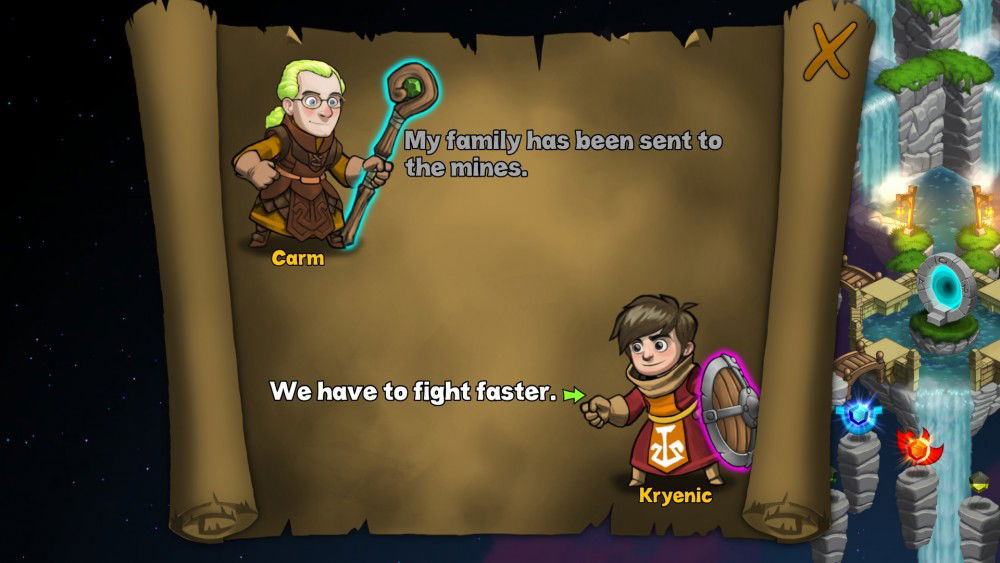
Rogue Wizards offers a Story mode, where dying will return you to your hub town and you can continue the ongoing campaign, and a Gauntlet mode, where you fight through an endless dungeon and death is permanent. General gameplay falls somewhere between Diablo and Heroes of Might and Magic; you’ll crawl randomly-generated dungeons from an isometric viewpoint, collecting treasure by opening chests and killing enemies in turn-based battle. Combat isn’t particularly complex, and exploration mostly involves walking from room to room until you find stairs to the next floor or the boss, making for an experience that becomes monotonous after a while. Fortunately, dungeons usually took about an hour each to complete, which ended up being as long as I could spend with the game before needing a break (this probably works out a little better on mobile platforms where players are more likely to have shorter play sessions). Each of the game’s monsters correspond with one of the six elements of magic, and campaign progression requires that you kill enough monsters of a particular element to open its ‘rift’ dungeon, meaning that you’ll have to run through several dungeons per element before gaining access to the final level and bosses. My playthrough clocked in at a little over seventeen hours.
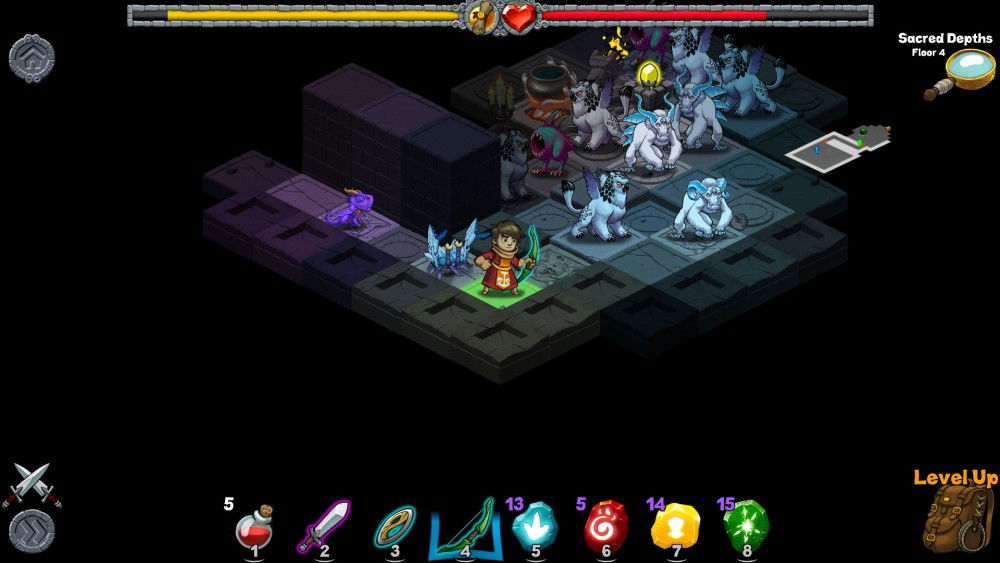
There’s a good variety of gear to mix and match, allowing you to build out your character pretty much however you want. As you increase your Mastery level of each individual piece of equipment, they can gain randomized enchantments that add perks like elemental magic damage to your attacks, additional target seeking for ranged weapons, or even XP bonuses every time you deal or receive damage. Stacking enchantments becomes integral to surviving as the dungeons get harder, and to cutting down on the time it takes to level up, which felt like a really slow process otherwise. The unfortunate downside is that new gear with higher base stats will most likely have few or no enchantments at first, forcing you to weigh the loss of crucial buffs against the potential to develop stronger equipment when you want to swap something out. I would try to hang on to items that had accrued several strong enchantments for as long as possible, but eventually give in and upgrade gear only to find myself suddenly struggling against monsters I was easily killing before. You end up collecting so much loot per dungeon that you could get stuck chasing your tail in this system for far longer than it’s worth.
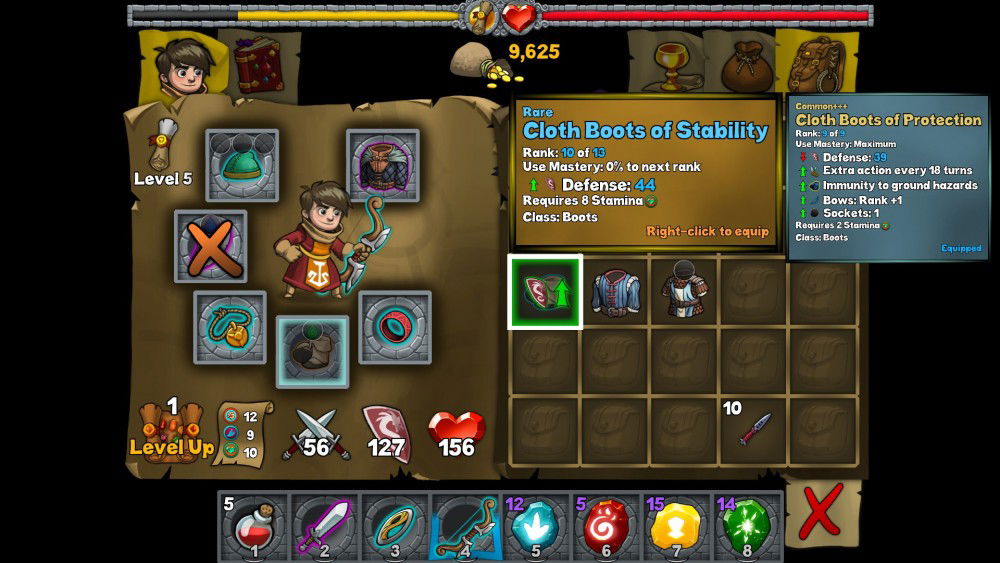
I didn’t feel like the game offered what could be considered actual town-building, one of its advertised features. Occasionally, you’ll find pet creatures and/or other Elam or Banlit NPCs in dungeons who will fight alongside you, then take up residence in your town afterward. A single pet can accompany you on further quests into dungeons, while the NPCs open up shops and remain sidelined until the end of the game. You do not get a choice of what shop they open or where it gets placed, and although you can upgrade them to sell you higher level gear, their inventories are randomized. I rarely found weapons or armor for sale that were better than what I’d found in dungeons, and in the few cases where I did, I was broke from paying to upgrade the shop. I got the most use out of the Enchanting Shrine that eventually opened in my town after deciding that it wasn’t worth spending the money to upgrade other shops over just rolling the dice on getting good buffs added to my existing equipment.
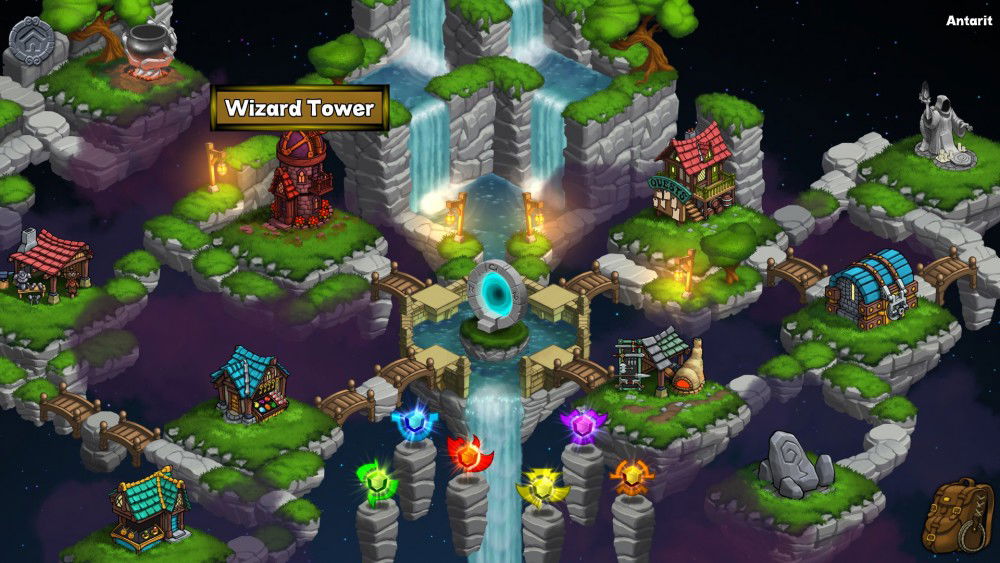
The interface seems to have been designed around tapping, likely for compatibility with mobile/tablet devices. This translates well enough to clicking with a mouse, which is fortunate because the game lacks controller support, and keyboard input is really only good for accessing your inventory since eight-directional movement on a diagonal plane doesn’t really map intuitively (but the option does exist). An action bar at the bottom of the screen allows you eight slots for equipping weapons, spells, and consumables. There are eighteen spells to learn in the game, so you’ll have to swap them out of your action bar depending on the dungeon and what you think you’ll need. This, and the fact that casting spells requires stacks of consumable items that I was always short on, discouraged me from using magic for the most part (I saved it mostly for boss battles, and otherwise relied on ranged and melee weapons). I failed to notice for a long time that the game indicates the current creature’s turn by coloring the tile under it green, because the effect is subtle and easy to miss. I would have liked a feature for showing you the pending order of turns, maybe like Final Fantasy X’s sidebar, but it’s perfectly playable without it.
Rogue Wizards has a clean, friendly, cartoony look, similar to many modern 2D mobile games. The hand-drawn characters are comprised of individual parts coupled together in jointed paper doll-fashion, while environmental details lack solid outlines. Although none of the character, monster, or environment designs are particularly remarkable (the Elam and Banlits look like regular humans, while monsters are all fairly generic), the overall presentation is consistent and solid. It was a little disappointing that boss monsters were always just larger versions of regular monsters, and the council wizards all utilized a single palette-swapped character model. The camera will zoom in on a boss monster at the beginning of battle, causing their appearance to become a little blurry; this was somewhat surprising as it indicates that the game is just stretching small sprites instead of using larger art assets, perhaps to keep its overall size compact enough for mobile downloads. Animations are fairly basic, generally involving simple swinging motions of limbs and facial expression swaps.
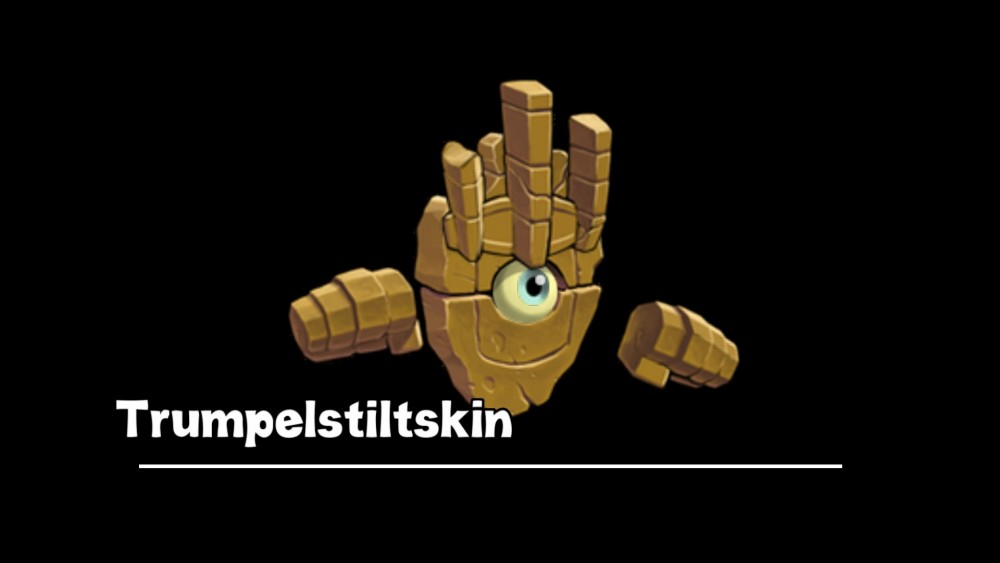
Dungeons feature color palettes and decor that match the elemental magic of the boss monster, which is a nice touch. Your character has a limited field of view around them that is affected by walls, certain spells, and whether you have pets or NPC allies extending your range, and tiles outside of your field of view are hidden. The default animation for when tiles enter and leave your field of vision is a rising and falling animation for each individual one, and I found this to be very distracting. Fortunately, two other options exist: a growing and shrinking animation, which I personally didn’t like either, and a simple fade in and out, which worked best for me.
My honest impression is that this game was intended to be played while muted, possibly another design choice made with mobile device compatibility and play style in mind. Dungeons feature forgettable, repetitive loops of ambient music that do nothing more than set a tone. One of these tracks actually has a hard cut at the looping point, which is noticeable and distracting. There’s a pretty, if not simple, tune that plays in your town, and tracks for during and after boss fights. Sound effects are mostly generic foley for things like sword clangs, explosions, and growls. The game does not feature any voice acting.
*Rogue Wizards was provided to us by Spellbind Studios for review purposes. For more information on how we review video games and other media/technology, please go review our Review Guideline/Scoring Policy for more info.
Overall
The random nature of so many of Rogue Wizards‘ elements guarantees experiences that are dynamic, but the repetitive core gameplay and tedium of inventory management can also make them monotonous. The Story mode’s narrative doesn’t add anything to make the gameplay more compelling, so you may be better off with the Gauntlet mode’s endless dungeon. Either way, this game works best in casual play sessions.
Pros:
- Lots of variety in gear
- Randomized enchantments granted to gear create the potential for powerful and unique builds
- XP bonuses for killing all monsters, finding all treasure chests, and disarming all traps on a floor incentivize exploration
Cons:
- Combat and exploration lack depth
- Losing enchantments from upgrading gear can really weaken your character or slow your progress and feels unbalanced
- Story mode’s narrative isn’t very interesting and delivered entirely through pages of text
- Music is very repetitive and seems like it was intended to be muted
-
Okay when played casually, but can get a bit monotonous


